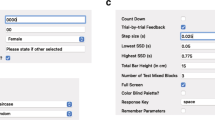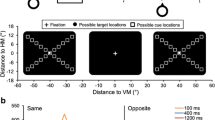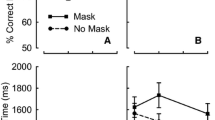Abstract
Inhibition of return (IOR) refers to the finding that targets appearing at previously cued locations are more slowly responded to than targets appearing at previously uncued locations when a relatively long temporal interval occurs between the cue and target. This experiment was conducted to determine whether the magnitude of IOR is influenced by the type of preceding trial (cued or uncued) and/or the location of the cue/target on the previous trial. Although no effect of cue/target location is observed, there was a marked effect of previous trial type, as IOR was greater following an uncued trial relative to a cued trial. This effect was attributable to differences in the response time as a function of previous trial type: specifically, participants were faster to respond to cued and uncued trials when the previous trial type was identical.


Similar content being viewed by others
Notes
Given the lower proportion of trials that were followed by the two previous identical trial types, we were unable to include target location as a variable in this analysis
References
Bertelson P. (1961). Sequential redundancy and speed in a serial two-choice responding task. Quarterly Journal of Experimental Psychology 13:90–120
Castel AD, Chasteen AL, Scialfa CT, Pratt J (2003) Adult age-differences in the time course of inhibition of return. Journal of Gerontology Psychological Sciences 58:256–259
Castel AD, Pratt J, Craik FIM (2003) The role of spatial working memory in inhibition of return: Evidence from divided attention tasks. Perception and Psychophysics 65:970–981
Dalrymple-Alford EC, Budayr B (1966) Examination of some aspects of the Stroop color-word test. Perceptual and Motor Skills 23:1211–1214
Danziger S. Kingstone A (1999) Unmasking the inhibition of return phenomenon. Perception and Psychophysics 61:1024–1037
Dodd MD, Castel AD, Pratt J (2003) Inhibition of return with rapid serial shifts of attention: Implications for memory and visual search. Perception and Psychophysics 65:1126–1135
Fecteau JH, Au C, Armstrong IT, Munoz DP (2004) Sensory biases produce alternation advantage found in sequential saccadic eye movement tasks. Experimental Brain Research 159:84–91
Gilchrist ID, Harvey M (2000) Refixation frequency and memory mechanisms in visual search. Current Biology 10:1209–1212
Horowitz TS, Wolfe JM (1998) Visual search has no memory. Nature 394:575–577
Horowitz TS, Wolfe JM (2001) Search for multiple targets: Remember the targets, forget the search. Perception and Psychophysics 63:272–285
Horowitz TS, Wolfe JM (2003) Memory for rejected distractors in visual search? Visual Cognition 10:257–298
Kessler K, Tipper SP (2004) Retrieval of implicit inhibitory processes: The impact of visual field, object-identity, and memory dynamics. Visual Cognition 11:965–995
Kirby NH (1976) Sequential effects in two-choice reaction time: automatic facilitation or subjective expectancy. Journal of Experimental Psychology Human Perception and Performance 2:567–577
Klein R (1988) Inhibitory tagging system facilitates visual search. Nature 334:430–431
Klein RM, Christie J, Morris EP (2005) Vector averaging of inhibition of return. Psychonomic Bulletin and Review 12:295–30
Klein RM, MacInnes WJ (1999) Inhibition of return is a foraging facilitator in visual search. Psychological Science 10:346–352
Larrison-Faucher A, Briand KA, Sereno AB (2002) Delayed onset of inhibition of return in schizophrenia. Progress in Neuro-Psychopharmacology and Biological Psychiatry 26:505–512
Logan GD (1988) Toward an instance theory of automatization. Psychological Review 95:492–527
Lowe DG (1979) Strategies, context, and the mechanism of response inhibition. Memory and Cognition 7:382–389
Lupianez J, Milan EG, Tornay FJ, Madrid E, Tudela P (1997) Does IOR occur in discrimination tasks? Yes, it does, but later. Perception and Psychophysics 59:1241–1254
MacLeod , C. M., Dodd, M. D., Sheard, E. D., Wilson, D. E., & Bibi, U. (2003). In opposition to inhibition. In B. H. Ross (Ed.), The psychology of learning and motivation (pp. 163–214). vol. 43, San Diego, CA: Academic
Maylor EA, Hockey GRJ (1985) Inhibitory component of externally controlled covert orienting in visual space. Journal of Experimental Psychology Human Perception and Performance 11:777–787
Maylor EA, Hockey GRJ (1987) Effects of repetition on the facilitatory and inhibitory components of orienting in visual space. Neuropsychologia 25:41–54
Moritz S, von Muhlenen A (2005) Inhibition of return in patients with obsessive–ompulsive disorder. Journal of Anxiety Disorders 19:117–126
Neill WT (1977) Inhibitory and facilitatory processes in attention. Journal of xperimental Psychology Human Perception and Performance 3:444–450
Neill , W. T., Mathis, K. M. (1998). Transfer-inappropriate processing Negative riming and related phenomena. In D. L. Medin (Ed.) The psychology of earning and motivation: Advances in research and theory (pp. 1–44). vol. 38, San Diego, CA: 561 Academic
Neill WT, Valdes LA (1992) The persistence of negative priming Steady-state or decay? Journal of Experimental Psychology Learning, Memory, and Cognition 18:565–576
Posner MI, Cohen Y (1984) Components of visual orienting. In: H. Bouma DG Bouwhuis (Eds) Attention and performance X: Control of language processes. Erlbaum, Hillsdale, NJ pp. 531–556
Pratt J (1995) Inhibition of return in a discrimination task. Psychonomic Bulletin and Review 2:117–120
Pratt J, Abrams RA (1999) Inhibition of return in discrimination tasks. Journal of Experimental Psychology Human Perception and Performance 25:229–242
Rafal RD, Calabresi PA, Brennan CW, Sciolto TK (1989) Saccade preparation inhibits reorienting to recently attended locations. Journal of Experimental Psychology Human Perception and Performance 15:673–685
Snyder JJ, Kingstone A (2001) Inhibition of return at multiple locations in visual search: When you see it and when you don’t. Quarterly Journal of Experimental Psychology Human Experimental Psychology 54:1221–1237
Soetens E (1998) Localizing sequential effects in serial choice reaction time with the information reduction procedure. Journal of Experimental Psychology Human Perception and Performance 24:547–568
Taylor TL, Klein RM (2000) Visual and motor effects in inhibition of return. Journal of Experimental Psychology Human Perception and Performance 26:1639–1656
Tipper SP (1985) The negative priming effect: Inhibitory priming by ignored objects. Quarterly Journal of Experimental Psychology 37A:571–590
Tipper SP (2001) Does negative priming reflect inhibitory mechanisms? A review and integration of conflicting views. Quarterly Journal of Experimental Psychology 54A:321–343
Tipper SP, Grison S, Kessler K (2003) Long-term inhibition of return of attention. Psychological Science 14:19–25
Wright RD, Richard CM (1996) Inhibition-of-return at multiple locations in visual space. Canadian Journal of Experimental Psychology 50:324–327
Acknowledgement
This research was supported by a Natural Sciences and Engineering Research Council (NSERC) grant to Jay Pratt. The authors would like to thank Avishai Henik and two anonymous reviewers for many helpful comments on a previous version of this manuscript.
Author information
Authors and Affiliations
Corresponding author
Rights and permissions
About this article
Cite this article
Dodd, M.D., Pratt, J. The effect of previous trial type on inhibition of return. Psychological Research 71, 411–417 (2007). https://doi.org/10.1007/s00426-005-0028-0
Received:
Accepted:
Published:
Issue Date:
DOI: https://doi.org/10.1007/s00426-005-0028-0




